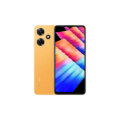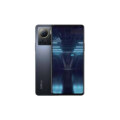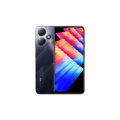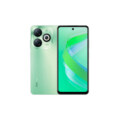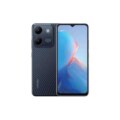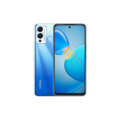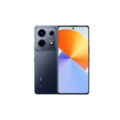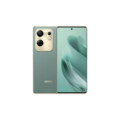Infinix Note 10 Pro
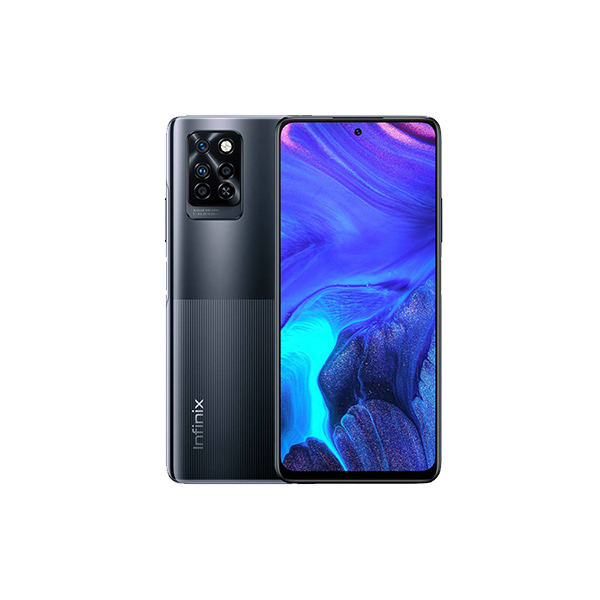

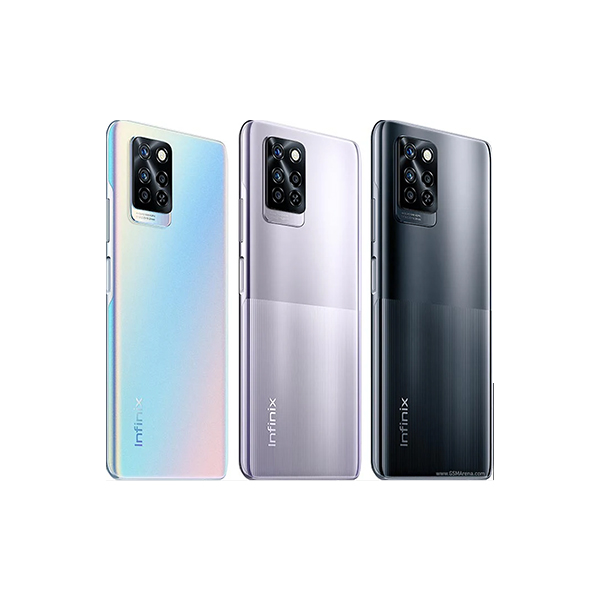
Specs
General
| Device Type | Infinix Phone |
| Announced | 12 May, 2021 |
| Released | 07 June, 2021 |
| Status | Discontinued |
Design
| Dimensions | 173.2 x 78.7 x 8.8 mm |
| Protection | Glass front, plastic frame, plastic back |
| Colors | Black, Purple, Nordic Secret |
Display
| Refresh Rate | 60 Hz |
| Display Type Display Technology => A number of display technologies and types used in mobile phones => TFT (Thin Film Transistor), IPS (In-Place Switching), OLED (Organic Light Emitting Diode), AMOLED (Active-Matrix Organic Light-Emitting Diode), Super AMOLED (an even advanced version of AMOLED), Resistive Touchscreen (Resistive touchscreens contain two layer of conductive material with a very small gap between them which acts as a resistance), Capacitive Touchsceen (Capacitive touchscreen technology consists of a layer of glass coated with a transparent conductor) | IPS LCD |
| Size | 6.95 inches |
| Resolution | 1080 x 2460 pixels |
| Display Colors Display Colors is refers to the number of different shades of colors that the screen is capable of displaying => 64K colors, 256K colors and 16 million colors, Obviously 16M is highest available range of colors and better than others. | 16M Colors |
| Pixel Density Pixel Density (PPI) is refers to the concentration of pixels on a particular display, measured in pixels per inch (ppi). Pixel density is calculated by dividing the diagonal pixel resolution of a display by its diagonal size, higher pixel density better display quality. | ~ 387 ppi |
| Touch Screen | Capacitive Touchscreen, Multitouch |
| Secondary Display | No |
Camera
| Front Camera | 16 MP |
| Camera Setup | Triple |
| Main Camera Camera is able to capture photographs and usually videos, The most important characteristics of a camera are the resolution (measured in megapixels), lens focus type (fixed or automatic), higher megapixel cameras are known to capture higher quality photos, but not always a good measurement of the photos quality. |
48 MP, PDAF 2 MP, f/2.4, (depth) 2 MP, f/2.4, (monochrome) |
| Video | 1440p@30fps, 1080p@30fps |
| Camera Features | Phase detection, Geo-tagging, Panorama, HDR |
| Flash Flash Light => There is commonly two types of flash lights are used in camera mobile phones, LED Flash (LED flash offers lower power consumption with drive circuitry that takes up very little room, LEDs can be strobed faster than any other light source), Xenon Flash (xenon flash produces an extremely intense full-spectrum white light for a very short duration) | Quad-LED flash |
Hardware
| Operating System OS => Every computer system run on a base software called Operating System (OS). Operating System controls all basic operations of the computer (such as smartphone, PDAs, tablet computers and other handheld devices). The Operating System allows the user to install and run third party applications (apps), apps are used to add new functionality to the device. | Android 11 |
| Chipset Chipset is a group of integrated circuits designed to perform one or a more dedicated functions, often with real time computing constraints, Popular smartphones are equipped with more advanced embedded chipsets that can do many different tasks depending on their programming. | Mediatek Helio G85 |
| CPU CPU (Central Processing Unit) mostly known as processors, CPU processes instructions in order to carry out certain functions that make your device operate properly. Processors are often described as the brain of computers, smartphones and tablets, Smartphones and tablets rely on processors to carry out their every task, Processors are an incredibly important factor in selecting any type of computing device, including your smartphone. | Octa-core (2x2.0 GHz Cortex-A75 & 6x1.8 GHz Cortex-A55) |
| Architecture | 64 bit |
| Fabrication | 12 nm |
| GPU GPU (Graphics Processing Unit) is a single-chip processor designed to rapidly manipulate and alter memory to accelerate the creation of images in a frame buffer intended for output to a display, This includes things such as lighting effects, object transformations, and 3D motion. | Mali-G52 MC2 |
| RAM (Memory) RAM (Random Access Memory) is a type of computer memory that can be accessed randomly, any byte of memory can be accessed without touching the preceding bytes that allows information to be stored and accessed quickly from random locations. RAM is the most common type of memory found in computer systems, smartphones, tablets and other electronic devices. | 8 GB |
| Internal Storage Internal Storage is a data storage space (flash memory) mostly used in smartphones, tablets and other electronic devices where operating system, apps, music, photos, videos, files and other user data Is stored. | 128GB Built-in |
| Card Slot Memory Card Slot is a special slot for inserting a memory card. Memory cards allow you to expand the phone's built-in memory, A memory card (sometimes called a flash memory card or a storage card) is a small storage medium used to store data such as text, pictures, audio, and video, for use on small, portable or remote computing devices such as mobile phones, mp3 players, digital cameras. | |
| Sensors Sensors are electronic components that detects and responds to some type of input from the physical environment. The specific input could be light, heat, motion, moisture, pressure and location, The output is generally a signal that is converted to use in computing systems, a location sensor, such as a GPS receiver is able to detect current location of your electronic device. | Accelerometer, Compass, Fingerprint (side mounted), Gyro, Proximity |
Network
| SIM TYPE SIM (Subscriber Identity Module) is a small card that contains mobile network subscriber's account information. This allows the phone using the card to attach to a mobile network. The SIM card is most commonly associated with GSM and UMTS mobile networks. Moving a SIM card from one phone to another allows a subscriber to switch mobile phones without having to contact their mobile network carrier. SIM cards can also be used by a phone to store limited amounts of data, such as phone numbers and text messages. | Nano SIM |
| SIM Technology | Dual Sim, Dual Standby (Nano-SIM) |
| 2G Network | GSM 850 / 900 / 1800 / 1900 |
| 3G Network | HSDPA 850 / 900 / 1700(AWS) / 1900 / 2100 |
| 4G Network | LTE band 1(2100), 3(1800), 5(850), 8(900), 40(2300), 41(2500) |
Multimedia
| FM Radio | |
| Stereo Speakers | NO |
| Loudspeaker | YES |
| Audio Jack | 3.5mm Audio Jack |
| Audio Features | Active noise cancellation with dedicated mic |
Connectivity
| Wi-fi Wi-Fi is a popular wireless networking technology using radio waves to provide high-speed network connections that allows devices to communicate without cords or cables, Wi-Fi is increasingly becoming the preferred mode of internet connectivity all over the world. | Wi-Fi 802.11 a/b/g/n/ac, dual-band, Wi-Fi Direct |
| Bluetooth Bluetooth is a wireless communications technology for exchanging data between mobile phones, headsets, computers and other network devices over short distances without wires, Bluetooth technology was primarily designed to support simple wireless networking of personal consumer devices. | 5.0, A2DP, LE |
| GPS GPS The Global Positioning System is a satellite-based radio navigation system, GPS permits users to determine their position, velocity and the time 24 hours a day, in all weather, anywhere in the world, In order to locate your position, your device or GPS receiver must have a clear view of the sky. | A-GPS support |
| USB | USB Type-C 2.0, OTG |
| EDGE EDGE (Enhanced Data GSM Environment) is a wireless network technology generally considered the next step in the 2G network offers data transfer rates up to four times faster than ordinary GSM networks, Generally, EDGE is used for the purpose of wireless data transfer, such as sharing pictures and videos or browsing the Internet via a mobile phone connection. | |
| GPRS GPRS (General Packet Radio Service) is a packet oriented mobile data service on the 2G and 3G cellular communication system's global system for mobile communications (GSM), Generally, GPRS is used for the purpose of wireless data transfer, such as sharing pictures and videos or browsing the Internet via a mobile phone connection. | |
| Speed | 3G (HSPA 42.2/5.76 Mbps, 4G (LTE Cat4 150/50 Mbps) |
| Wi-fi Hotspot | |
| NFC NFC (Near field communication) is a set of standards for smartphones and similar devices to establish peer-to-peer radio communications with each other by touching them together or bringing them into proximity, usually no more than a few inches. |
Features
| Messaging | SMS(threaded view), MMS, Email, Push Mail, IM |
| Web Browser Web Browser => a web browser is a software application used to locate, retrieve and display content on the World Wide Web, including Web pages, images, video and other files, The primary function of a web browser is to render HTML, the code used to design or markup webpages. | HTML5 |
| Games | Built-in + Downloadable |
| Torch |
Battery
| Battery Type Battery Type => Cell phones run on various kinds of batteries depending on the manufacturer, phone size or shape and features. There are basically four types of cell phone batteries => Lithium Polymer, Lithium Ion, Nickel Metal Hydride and Nickel Cadmium. | Li-Ion (Lithium Ion) |
| Capacity Battery Capacity is a measure (typically in Amp-hr) of the charge stored by the battery, and is determined by the mass of active material contained in the battery. The battery capacity represents the maximum amount of energy that can be extracted from the battery under certain conditions. | 5000 mAh |
| Placement | Non-removable |
| Wireless Charging Wireless Charging (Inductive Charging) uses an electromagnetic field to transfer energy between two objects. This is usually done with a charging station. Energy is sent through an inductive coupling to an electrical device, which can then use that energy to charge batteries or run the device. | No |
| Extra | Fast battery charging 33W |
Infinix Note 10 Pro Detailed Review
Introduction: The Infinix Note 10 Pro was launched in May 2021 as a part of Infinix’s Note series, aimed at delivering a powerful smartphone experience at an affordable price. Known for its large display, capable performance, and versatile camera setup, the Note 10 Pro caters to users looking for a feature-packed device without breaking the bank. This review covers the design, display, performance, camera system, battery life, software, and more, highlighting both the pros and cons.
Specifications at a Glance
- Display: 6.95-inch Full HD+ IPS LCD (1080 x 2460 pixels, 387 ppi)
- Processor: MediaTek Helio G95 chipset
- RAM: 6 GB / 8 GB
- Storage Options: 64 GB, 128 GB, 256 GB (expandable via microSD up to 2TB)
- Rear Cameras: Quad setup – 64 MP (wide), 8 MP (ultrawide), 2 MP (depth), 2 MP (monochrome)
- Front Camera: 16 MP
- Battery: 5000mAh with 33W fast charging
- Operating System: Android 11 with XOS 7.6
- Audio: Dual speakers, 3.5mm headphone jack
- Dimensions: 172.8 x 78.3 x 7.8 mm
- Weight: 209 grams
Design and Build Quality
Aesthetics:
- The Infinix Note 10 Pro has a sleek and modern design with a glossy polycarbonate back that gives it a premium look, though it is prone to fingerprints.
- Available in various colors like Black, Purple, and Nordic Secret, the design is trendy and appealing to a wide range of users.
Durability:
- While the polycarbonate build keeps the phone lightweight, it may not offer the same durability as metal or glass-backed phones. A protective case is recommended to avoid scratches.
- The plastic frame and back make it more resistant to drops, but it does lack official IP water or dust resistance ratings.
Ergonomics:
- Despite its large 6.95-inch display, the slim 7.8mm profile and well-curved edges make the Infinix Note 10 Pro relatively comfortable to hold, though one-handed usage may still be a challenge due to its size.
- The fingerprint scanner is conveniently integrated into the power button on the side for quick and secure access.
Overall, the Infinix Note 10 Pro offers a good balance between style and practicality with a modern design, though its large size may not suit everyone.
Display
Specifications:
- Size: 6.95-inch Full HD+ IPS LCD Display
- Resolution: 1080 x 2460 pixels (387 ppi)
- Refresh Rate: 90Hz
- Brightness: 480 nits (typical)
Performance:
- Large and Immersive: The Note 10 Pro’s 6.95-inch display is perfect for multimedia consumption, gaming, and productivity, offering ample screen real estate with a punch-hole design for minimal distraction.
- Smooth and Fluid: The 90Hz refresh rate ensures smooth scrolling and transitions, especially noticeable in gaming and general navigation, though it’s not as fluid as OLED panels.
- Vibrant Colors: The display delivers vibrant colors and decent contrast, though not on par with AMOLED screens. It performs well under most lighting conditions, but outdoor visibility could be improved in direct sunlight.
In conclusion, the Infinix Note 10 Pro’s large, 90Hz display enhances the overall viewing and gaming experience, making it ideal for users who consume a lot of content.
Performance
Hardware:
- Processor: MediaTek Helio G95 (12nm)
- RAM: 6 GB / 8 GB
- Storage: 64 GB / 128 GB / 256 GB (expandable up to 2TB via microSD)
Performance Evaluation:
- Smooth Multitasking: Powered by the MediaTek Helio G95, the Note 10 Pro handles daily tasks, multitasking, and moderate gaming with ease. The 6 GB or 8 GB RAM options ensure smooth app switching, and there’s minimal lag for most everyday activities.
- Gaming Performance: The Helio G95 chipset is optimized for gaming, offering good performance in titles like PUBG Mobile and Call of Duty: Mobile at medium to high settings. The 90Hz refresh rate also enhances gaming responsiveness.
- Storage Flexibility: With up to 256 GB of internal storage and microSD expansion support, users have plenty of room for apps, media, and files.
In summary, the Infinix Note 10 Pro delivers solid performance for its price range, making it suitable for both productivity and gaming enthusiasts.
Camera
Rear Cameras:
- Primary: 64 MP (f/1.8) wide
- Ultrawide: 8 MP (f/2.3) with a 120° field of view
- Depth Sensor: 2 MP (f/2.4)
- Monochrome: 2 MP (f/2.4)
Front Camera:
- Selfie Shooter: 16 MP (f/2.0)
Camera Performance:
- Daylight Photography: The 64 MP main sensor captures sharp and detailed images in good lighting conditions, with vibrant colors and decent dynamic range. The AI enhancements improve clarity and color balance.
- Low-Light Performance: In low-light situations, the camera struggles a bit with noise, but the Super Night Mode helps enhance brightness and detail, though results are inconsistent.
- Ultrawide Shots: The 8 MP ultrawide sensor is adequate for wide-angle shots, but there’s a noticeable drop in detail and dynamic range compared to the main camera.
- Selfie Camera: The 16 MP front camera delivers clear and well-exposed selfies, though it can over-soften facial details in certain lighting conditions.
Video Recording:
- The Note 10 Pro can record 4K video at 30fps and 1080p at 60fps, with good stabilization and color accuracy. Video quality is decent, but low-light performance could be better.
In conclusion, the Infinix Note 10 Pro’s camera system is versatile, offering a solid main sensor for daylight photography but performing less impressively in low light and ultrawide shots.
Battery Life
Specifications:
- Battery Capacity: 5000mAh
- Charging Speed: 33W fast charging
Performance:
- All-Day Battery: The 5000mAh battery provides excellent endurance, easily lasting through a full day of moderate to heavy usage, including gaming, streaming, and multitasking.
- Fast Charging: The 33W fast charging support is a plus, allowing the battery to charge from 0% to around 50% in just 30 minutes, which is great for users on the go.
In summary, the Infinix Note 10 Pro excels in battery life, offering long-lasting performance with fast charging capabilities.
Software
Operating System:
- OS: Android 11 with XOS 7.6
User Experience:
- Customization: XOS 7.6 offers a highly customizable experience with various themes, gestures, and smart features like Smart Panel for quick access to apps and tools.
- Bloatware: The software comes pre-loaded with some bloatware, though most of it can be removed or disabled.
- Updates: While Android 11 is smooth, there’s no clear information about future software updates or how long Infinix will support the device.
In conclusion, the Infinix Note 10 Pro provides a feature-rich software experience, though some users may find the pre-installed bloatware annoying.
Pros & Cons
Pros:
- Large 6.95-inch 90Hz Display: Ideal for media consumption, gaming, and multitasking.
- Solid Performance: The Helio G95 chipset ensures smooth multitasking and gaming.
- Versatile Camera Setup: Good main camera performance, especially in daylight.
- Excellent Battery Life: The 5000mAh battery with 33W fast charging offers long-lasting power.
- Expandable Storage: Supports microSD cards up to 2TB.
Cons:
- Low-Light Camera Performance: Struggles in low-light conditions and with the ultrawide sensor.
- No AMOLED Display: IPS LCD is good, but an AMOLED panel would have been better for deeper blacks and punchier colors.
- Bloatware: XOS has pre-installed apps that may clutter the user experience.
- No 5G Support: In a market shifting towards 5G, the lack of 5G could be a dealbreaker for some users.
Conclusion: The Infinix Note 10 Pro offers excellent value for its price, with a large 90Hz display, capable performance, a versatile camera system, and long battery life. While it has a few drawbacks, such as inconsistent low-light photography and the absence of 5G, it remains a strong contender for budget-conscious users who want a feature-packed device for everyday use and gaming.
Review
Disclaimer Note
All prices in Pakistan is updated daily from the price list provided by local shops and dealers but we can not guarantee that the information / price on this page is 100% correct (Human error is possible), always visit your local shop for exact cell phone cost & rate.

